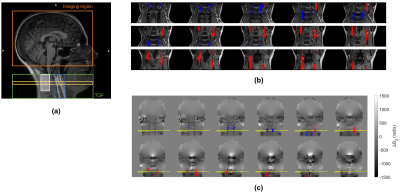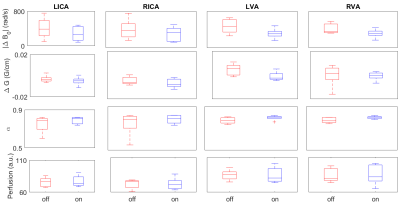1420
Brain perfusion imaging using pseudo-continuous arterial spin labelling MRI: impact of RF coil shimming of the labelling region1Institute for Systems and Robotics - Lisboa and Department of Bioengineering, Instituto Superior Técnico, Universidade de Lisboa, Lisboa, Portugal, 2Hospital da Luz Learning Health, Lisboa, Portugal, 3Hospital da Luz, Lisboa, Portugal
Synopsis
The labelling efficiency of pCASL perfusion imaging sequences can be hampered by B0 field inhomogeneities. We assessed the impact of shimming the labelling region using a commercial RF coil with dedicated shiming channels in the neck, on data acquired from healthy volunteers. Brain perfusion was quantified, as well as the labelling efficiency (based on B0 fieldmaps and numerical simulations). Simulation experiments show that labelling efficiency significantly depends on B0 field inhomogeneity. In vivo experiments, however, showed subtle inhomogeneity reduction within the arteries in the labelling region, yielding no significant improvements in pCASL labelling efficiency or the respective perfusion signal.
Introduction
Pseudo-continuous arterial spin labelling (pCASL) presents the highest SNR of all ASL perfusion imaging techniques, but can be hampered by suboptimal labelling efficiency. One major limiting factor is the presence of B0 field inhomogeneities in the labelling region, the source of which can be imperfect shimming of this region1. Advanced RF coil technologies have become commercially available, enabling improved inhomogeneity correction by using dedicated shimming channels. Here, we evaluate the impact of shimming the labelling region using a commercial RF coil on the labelling efficiency and perfusion measurement using pCASL, combining real data acquisition with simulations.Materials and Methods
SimulationsThe behavior of a single spin moving along the z-direction and subjected to a pCASL sequence was simulated in Matlab and the ensuing labelling efficiency (α) was estimated, as in1. The pCASL parameters were matched to the sequence used and a realistic distribution of flow velocities was considered1. In order to evaluate the effects of field inhomogeneity (∆B0) and off-resonance gradient (∆G) on α, simulations were carried out for a range of off-resonance values.
In Vivo Data
Ten pCASL datasets were obtained from 8 healthy subjects on a 3T Vida MRI system (Siemens Healthineers) using the 64-channel head/neck RF coil with BioMatrix Coil Shim technology2, with (“on”) and without (“off”) shimming of the labelling region. A single-delay pCASL acquisition with a 3D GRASE readout was performed using Siemens product sequence: labelling duration=1800ms, post-labelling delay (PLD)=1800ms, TR/TE=5600/18.4ms, voxel size=3.8x3.8x4.0mm3, 8 control/label pairs. Fieldmaps were acquired covering both the labelling and imaging regions. A 2D TOF angiography was acquired in order to prescribe the labelling plane, placed slightly above the carotid bifurcation, perpendicular to the internal carotid arteries (ICAs). T1-weighted structural image was acquired using a 3D MPRAGE sequence.
pCASL data were analysed using FSL’s BASIL toolset3, to obtain relative perfusion (f) images in each condition. All images were co-registered with the T1-weighted structural image using FSL tools (fsl.fmrib.ox.ac.uk). ROIs were defined around the ICAs and vertebral arteries (VAs) based on the TOF, extending +/-20mm along z. The B0 and gradient variations along z (∆B0 and ∆G) were quantified in these ROIs based on each fieldmap, and simulations were performed in order to estimate α for the respective pCASL acquisitions. Figure 1 summarizes the in vivo data processing pipeline.
Results and Discussion
The results of the simulation experiments are presented in Figure 2, showing that ∆B0 and ∆G may have a strong impact on the value of α. These results indicate that reducing field inhomogeneity in the labelling region achieved with RF coil shiming may have a positive impact on the α and hence on the perfusion-weighted signal and resulting perfusion images.The effects of RF coil shiming on B0 field inhomogeneity and perfusion signal are illustrated in Figures 3 and 4, respectively. The group results are presented in Figure 5, showing the distributions across all subjects of the average ∆B0 and ∆G in each artery ROI, the ensuing α, and the corresponding relative perfusion averaged in cortical GM within the respective arterial territory.
When comparing the shim “on” vs. “off” conditions, an overall reduction in ∆B0 of 27±19% was obtained for the artery ROIs, while in the control region a much larger reduction of 53±17% was obtained. This suggests that, although RF coil shiming is effective, its effects are only minor in the desired labelling region; this can probably be explained by the fact that the shimming elements in the head/neck RF coil are located in its inferior part. The corresponding reduction in ∆G was 9±3%. Together, these values yielded an increase in the simulated α of 5±9%. The corresponding change in the measured average cortical GM perfusion was 0.7±7%. These relative changes in perfusion and α, between the coil shiming "off"/"on" conditions, were not significantly different from 0, as assessed using a Mann-Whitney U-test (p<0.05).
The within-subject coefficient of variation (CVw)4 was computed for the perfusion estimates (averaged across cortical GM) obtained in the two conditions. The CVw values ranged from 8.0 to 27.6%, with an average of 12.3%. For comparison, test-retest studies have reported CVw values ranging from 3.5 to 21.0% for pCASL perfusion measurements5,6. In such studies, perfusion measurements are obtained for each subject, over two sessions using the same acquisition parameters, with the aim of assessing reproducibility. Thus, even when reproducing perfusion measurements in ideally identical conditions, relatively large variations are observed, of the same order of magnitude of the variations we found. The perfusion signal increase that would be expected between “off”/”on” conditions, based on the estimated increase in α, would be of 5% on average, which is within the previously reported within-subject variability.
Conclusion
Our results provide no evidence of improved pCASL labelling efficiency or respective perfusion signal by using additional shimming of the labelling region. Although the RF coil shiming was effective in reducing B0 field inhomogeneities, the reduction within the arteries in the labelling region was very subtle, yielding no significant increase in the simulated labelling efficiency. Regardless of significance, it would still not be possible to detect the estimated 5% increase in perfusion signal, since this is within the reported within-subject variability of similar pCASL perfusion measurements.Acknowledgements
We acknowledge the Portuguese Science Foundation through grants PTDC/EMD-EMD/29675/2017, LISBOA-01-0145-FEDER-029675 and UIDB/50009/2020.References
1. Jahanian, H. et. al. B0 field inhomogeneity considerations in pseudo-continuous arterial spin labeling (pcasl): effects on tagging efficiency and correction strategy. NMR Biomed 2011; 24:1202–1209.
2. Keil, M. R. et. al. Biomatrix tuners: Coilshim. http://clinical-mri.com/wp-content/uploads/2017/03/BioMatrix_CoilShim_MAGNETOM_Vida.pdfChappell,
3. M. et. al. Variational bayesian inference for a non-linear forward model. IEEE Trans. Signal Process. 2009; 57:223–236.
4. Pinto, J. et. al. Fourier modeling of the bold response to a breath-hold task: Optimization and reproducibility. NeuroImage 2016; 135:223–231.
5. Chen, Y. et al. Test-retest reliability of arterial spin labeling with common labeling strategies. Journal of Magnetic Resonance Imaging 2011; 33:940–949.
6. Sousa, I. et al. Reproducibility of the quantification of arterial and tissue contributions in multiple postlabeling delay arterial spin labeling. Journal of Magnetic Resonance Imaging 2014; 40:1453–1462.
7. Gevers, S. et al. Intra- and multi-center reproducibility of pulsed, continuous and pseudo-continuous arterial spin labeling methods for measuring cerebral perfusion. Journal of Cerebral Blood Flow Metabolism 2011; 31:1706–1715.
8. Mezue, M. et al. Optimization and reliability of multiple postlabeling delay pseudo-continuous arterial spin labeling during rest and stimulus-induced functional task activation. Journal of Cerebral Blood Flow Metabolism 2014; 34:1919–1927.
Figures



